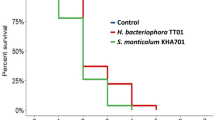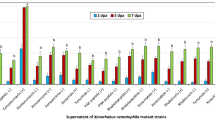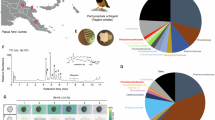Abstract
Entomopathogenic bacteria of the genus Xenorhabdus are known to be symbiotically associated with soil dwelling nematodes of the Steinernematidae family. These bacteria are transported by their nematode hosts into the hemocoel of the insect larvae, where they proliferate and produce insecticidal proteins, inhibitors of the insect immune system and antimicrobial molecules. In this study, we describe the discovery of a new family (PAX) of five antimicrobial compounds produced by fermentation of the Xenorhabdus nematophila F1 strain and purified by cation exchange chromatography and reversed phase chromatography. The chemical structure of PAX 3, a lysine-rich cyclolipopetide, was obtained from the analysis of homo and heteronuclear 2D NMR and confirmed by MS-MS experiments. The five members of the PAX family showed significant activity against plants and human fungal pathogens and moderate activity against few bacteria and yeast. No cytotoxicity was observed on CHO or insect cells.
Similar content being viewed by others
Log in or create a free account to read this content
Gain free access to this article, as well as selected content from this journal and more on nature.com
or
References
Poinar, G. O. J. The presence of Achromobacter nematophilus in the infective stage of a Neoaplectana sp. (Steinernematidae: Nematoda). Nematologica 12, 105–108 (1966).
Akhurst, R. J. Neoaplectana species: Specificity of association with bacteria of the genus Xenorhabdus. Exp. Parasitol. 55, 258–263 (1983).
Herbert, E. E. & Goodrich-Blair, H. Friend and foe: the two faces of Xenorhabdus nematophila. Nat. Rev. Microbiol. 5, 634–646 (2007).
Kaya, H. K. & Gaugler, R. Entomopathogenic nematodes. Ann. Rev. Entomol. 38, 181–206 (1993).
Brown, S. E. et al. Txp40, a ubiquitous insecticidal toxin protein from Xenorhabdus and Photorhabdus bacteria. Appl. Environ. Microbiol. 72, 1653–1662 (2006).
Park, Y. & Kim, Y. Eicosanoids rescue Spodoptera exigua infected with Xenorhabdus nematophilus, the symbiotic bacteria to the entomopathogenic nematode Steinernema carpocapsae. J. Insect. Physiol. 46, 1469–1476 (2000).
Park, Y., Kim, Y. & Stanley, D. The bacterium Xenorhabdus nematophila inhibits phospholipases A2 from insect, prokaryote, and vertebrate sources. Naturwissenschaften 91, 371–373 (2004).
Vigneux, F. et al. The xaxAB genes encoding a new apoptotic toxin from the insect pathogen Xenorhabdus nematophila are present in plant and human pathogens. J. Biol. Chem. 282, 9571–9580 (2007).
Forst, S., Dowds, B., Boemare, N. & Stackebrandt, E. Xenorhabdus and Photorhabdus spp.: bugs that kill bugs. Annu. Rev. Microbiol. 51, 47–72 (1997).
Webster, J. M., Chen, G., Hu, K. & Li, J. Bacterial metabolites. In Entomopathogenic Nematology (ed. Gangler, R.) 99–114 (CABI Publishing, New York, 2002).
Boemare, N. E., Boyer-Giglio, M. H., Thaler, J. O., Akhurst, R. J. & Brehelin, M. Lysogeny and bacteriocinogeny in Xenorhabdus nematophilus and other Xenorhabdus spp. Appl. Environ. Microbiol. 58, 3032–3037 (1992).
McInerney, B. V. et al. Biologically active metabolites from Xenorhabdus spp., Part 1. Dithiolopyrrolone derivatives with antibiotic activity. J. Nat. Prod. 54, 774–784 (1991).
McInerney, B. V., Taylor, W. C., Lacey, M. J., Akhurst, R. J. & Gregson, R. P. Biologically active metabolites from Xenorhabdus spp., Part 2. Benzopyran-1-one derivatives with gastroprotective activity. J. Nat. Prod. 54, 785–795 (1991).
Li, J., Chen, G., Webster, J. M. & Czyzewska, E. Antimicrobial metabolites from a bacterial symbiont. J. Nat. Prod. 58, 1081–1086 (1995).
Li, J., Chen, G. & Webster, J. M. Nematophin, a novel antimicrobial substance produced by Xenorhabdus nematophilus (Enterobactereaceae). Can. J. Microbiol. 43, 770–773 (1997).
Webster, J. M., Chen, G., Hu, K. & Li, J. Bacterial metabolites. Entomopathogenic Nematology 99–114 (2002).
Ji, D. et al. Identification of an antibacterial compound, benzylideneacetone, from Xenorhabdus nematophila against major plant-pathogenic bacteria. FEMS Microbiol. Lett. 239, 241–248 (2004).
Thaler, J. O., Baghdiguian, S. & Boemare, N. Purification and characterization of xenorhabdicin, a phage tail-like bacteriocin, from the lysogenic strain F1 of Xenorhabdus nematophilus. Appl. Environ. Microbiol. 61, 2049–2052 (1995).
Lang, G., Kalvelage, T., Peters, A., Wiese, J. & Imhoff, J. F. Linear and cyclic peptides from the entomopathogenic bacterium Xenorhabdus nematophilus. J. Nat. Prod. 71, 1074–1077 (2008).
Akhurst, R. J. Morphological and functional dimorphism in Xenorhabdus spp., bacteria symbiotically associated with the insect pathogenic nematodes Neoplectana and Heterorhabditis. J. Gen. Microbiol. 121, 303–309 (1980).
Boemare, N. E. & Akhurst, R. J. Biochemical and physiological characterization of colony form variants in Xenorhabdus spp. (Enterobacteriaceae). J. Gen. Microbiol. 134, 751–761 (1988).
De Lucca, A. J. & Walsh, T. J. Antifungal peptides: novel therapeutic compounds against emerging pathogens. Antimicrob. Agents Chemother. 43, 1–11 (1999).
Fiechter, A. Biosurfactants: moving towards industrial application. Trends Biotechnol. 10, 208–217 (1992).
Raaijmakers, J. M., de Bruijn, I. & de Kock, M. J. Cyclic lipopeptide production by plant-associated Pseudomonas spp.: diversity, activity, biosynthesis, and regulation. Mol. Plant. Microbe Interact. 19, 699–710 (2006).
Jeu, L. & Fung, H. B. Daptomycin: a cyclic lipopeptide antimicrobial agent. Clin. Ther. 26, 1728–1757 (2004).
Evans, M. E., Feola, D. J. & Rapp, R. P. Polymyxin B sulfate and colistin: old antibiotics for emerging multiresistant Gram-negative bacteria. Ann. Pharmacother. 33, 960–967 (1999).
Sauermann, R., Rothenburger, M., Graninger, W. & Joukhadar, C. Daptomycin: a review 4 years after first approval. Pharmacology 81, 79–91 (2008).
Danner, R. L. et al. Purification, toxicity, and antiendotoxin activity of polymyxin B nonapeptide. Antimicrob. Agents Chemother. 33, 1428–1434 (1989).
Denning, D. W. Echinocandins: a new class of antifungal. J. Antimicrob. Chemother. 49, 889–891 (2002).
Weis, F., Beiras-Fernandez, A. & Schelling, G. Daptomycin, a lipopeptide antibiotic in clinical practice. Curr. Opin. Investig. Drugs 9, 879–884 (2008).
Denning, D. W. Echinocandin antifungal drugs. Lancet 362, 1142–1152 (2003).
Nelson, P. E., Dignami, M. C. & Anaissie, E. J. Taxonomy, biology, and clinical aspects of Fusarium species. Clin. Microbiol. Rev. 7, 479–504 (1994).
Boutati, E. I. & Anaissie, E. J. Fusarium, a significant emerging pathogen in patients with hematologic malignancy: ten years’ experience at a cancer center and implications for management. Blood 90, 999–1008 (1997).
Hennequin, C. et al. Invasive Fusarium infections: a retrospective survey of 31 cases. The French Groupe d’Etudes des Mycoses Opportunistes. J. Med. Vet. Mycol. 35, 107–114 (1997).
Morrison, V. A., Haake, R. J. & Weisdorf, D. J. The spectrum of non-Candida fungal infections following bone marrow transplantation. Medicine 72, 78–89 (1993).
Guarro, J. & Gene, J. Fusarium infections. Criteria for the identification of the responsible species. Mycoses 35, 109–114 (1992).
Pfeffer, S., Hohne, W., Branner, S., Wilson, K. & Betzel, C. X-Ray structure of the antibiotic bacitracin A. FEBS Lett. 285, 115–119 (1991).
National Committee for Clinical Laboratory Standards. Methods for Dilution Antimicrobial Susceptibility Tests for Bacteria that Grow Aerobically, 6th edn, Approved Standard M07-A6. (NCCLS, Villanova, PA, USA, 2003).
National Committee for Clinical Laboratory Standards. Reference Method for Broth Dilution Antifungal Susceptibility Testing of Filamentous Fungi. Approved standard. NCCLS document M38-A. (Clinical and Laboratory Standards Institute, Villanova, PA, 2002).
National Committee for Clinical Laboratory Standards. Development of In Vitro Susceptibility Testing Criteria and Quality Control Parameters. Approved guideline, 2nd edn. NCCLS document M23-A2 (Clinical and Laboratory Standards Institute, Villanova, PA, 2001).
National Committee for Clinical Laboratory Standards. Reference Method for Broth Dilution Antifungal Susceptibility Testing of Yeasts. Approved standard, 2nd edn. NCCLS document M27-A2 (Clinical and Laboratory Standards Institute, Villanova, PA, 2002).
Poitout, S. & Bues, R. Elevage de plusieurs espèces de Lépidoptères Noctuidae sur milieu artificiel riche et sur milieu artificiel simplifié. Ann. Zool. Ecol. Anim. 2, 79–91 (1970).
Ahmad, I. M., Waldbauer, G. P. & Friedman, S. A defined artificial diet for the larvae of Manduca sexta. Entomol. Exp. Appl. 53, 189–191 (1989).
Rowe, G. E. & Welch, R. A. Assays of hemolytic toxins. Methods Enzymol. 235, 657–667 (1994).
Anggraeni, T. & Ratcliffe, N. A. Studies on cell-cell cooperation during phagocytosis by purified haemocyte populations of the wax moth, Galleria mellonella. J. Insect. Physiol. 37, 453–460 (1991).
Rance, M. et al. Improved spectral resolution in cosy 1H NMR spectra of proteins via double quantum filtering. Biochem. Biophys. Res. Commun. 117, 479–485 (1983).
Derome, A. E. & Williamson, M. P. 2D homonuclear shift correlation phase sensitive using TPPI with double quantum filter phase cycle. J. Magn. Reson. 88, 177–185 (1990).
Bax, A. & Davis, G. D. Practical aspects of two-dimensional treansverse NOE spectroscopy. J. Magn. Reson. 65, 355–360 (1985).
Rance, M. Improved techniques for homonuclear rotating-frame and isotropic mixing experiments. J. Magn. Reson. 74, 557–564 (1987).
Macura, S., Huang, Y., Sutter, D. & Ernst, R. R. Two-dimensional chemical exchange and cross-relaxation spectroscopy of coupled nuclear spins. J. Magn. Reson. 43, 259–281 (1981).
Marion, D., Ikura, M., Tschudin, R. & Bax, A. Rapid recording of 2D NMR-spectra without phase cycling-application to the study of hydrogen-exchange in proteins. J. Magn. Reson. 85, 393–399 (1989).
Bodenhausen, G. & Ruben, D. J. Natural abundance nitrogen-15 NMR by enhanced heteronuclear spectroscopy. Chem. Phys. Lett. 69, 185–189 (1980).
Bax, A. & Summers, M. F. 1H and 13C assignments from sensitivity-enhanced detection of heteronuclear multiple-bond connectivity by 2D multiple quantum NMR. J. Am. Chem. Soc. 108, 2093–2094 (1986).
Bax, A. & Marion, D. Improved resolution and sensitivity in 1H-detected heteronuclear multiple-bond correlation spectroscopy. J. Magn. Reson. 78, 186–191 (1988).
Wüthrich, K. NMR of Proteins and Nucleic Acids (John Wiley & Sons, New York, 1986).
Author information
Authors and Affiliations
Corresponding author
Rights and permissions
About this article
Cite this article
Gualtieri, M., Aumelas, A. & Thaler, JO. Identification of a new antimicrobial lysine-rich cyclolipopeptide family from Xenorhabdus nematophila. J Antibiot 62, 295–302 (2009). https://doi.org/10.1038/ja.2009.31
Received:
Accepted:
Published:
Issue date:
DOI: https://doi.org/10.1038/ja.2009.31
Keywords
This article is cited by
-
Genome mining reveals novel biosynthetic gene clusters in entomopathogenic bacteria
Scientific Reports (2023)
-
Endosymbiotic microbes from entomopathogenic nematode (EPNs) and their applications as biocontrol agents for agro-environmental sustainability
Egyptian Journal of Biological Pest Control (2022)
-
Antiprotozoal activity of different Xenorhabdus and Photorhabdus bacterial secondary metabolites and identification of bioactive compounds using the easyPACId approach
Scientific Reports (2022)
-
Relative potency of a novel acaricidal compound from Xenorhabdus, a bacterial genus mutualistically associated with entomopathogenic nematodes
Scientific Reports (2021)
-
Antifungal activity of Xenorhabdus spp. and Photorhabdus spp. against the soybean pathogenic Sclerotinia sclerotiorum
Scientific Reports (2020)



